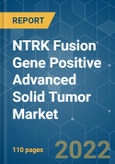The NTRK Fusion Gene Positive Advanced Solid Tumor market is anticipated to grow with a CAGR of nearly 5.4%, during the forecast period.
Certain factors that are driving the market growth include increasing prevalence of cancer and growing research and development activities. Globally, cancer is one of the leading causes of death. The disease witnessed significant growth in the last few decades, and it is expected to grow rapidly over the forecast period.
The World Health Organization (WHO) estimates the rate of cancer number to increase by 70% over the next two decades. Additionally, the increased burden of several lifestyle disorders is also expected to drive the market, as biomarkers play a vital role in risk assessment, early diagnosis, and effective monitoring of treatment.
FDA's approval of entrectinib for neurotrophic tyrosine receptor kinase (NTRK) fusion-positive tumors represents a new paradigm in cancer treatment. It treats a cancer based on a common biomarker seen across different tumors rather than based on the location in the body where the cancer originated.
Key Market Trends
Diagnostics Segment Holds Significant Share in the Global NTRK Fusion Gene Positive Advanced Solid Tumor Market
There are multiple methods for identifying NTRK fusions, including pan-TRK immunohistochemistry, fluorescence in situ hybridization and sequencing methods. FISH and RT-PCR have been successfully used in the clinic to detect NTRK fusions and are reasonable alternatives to NGS, especially for tumor histologies with a high prevalence of NTRK fusions involving recurrent partners (MASC, infantile fibrosarcomas, secretory breast carcinoma, and cellular or mixed congenital mesoblastic nephromas). Recent approvals add to the growth of the segment share. In 2018, SeraCare Life Sciences, a manufacturer and leading partner to global in vitro diagnostics manufacturers and clinical laboratories, launched an expanded neurotrophic tropomyosin receptor kinase (NTRK) RNA fusion reference material panel developed in a partnership with Bayer.
North America Dominates the Global NTRK Fusion Gene Positive Advanced Solid Tumor Market
As per the American Cancer Society, in 2018, the United States witnessed around 164,690 new cases of prostate cancer, causing over 26,430 deaths. About 60% of the total prostate cancer cases diagnosed are among men aged 65 years or older. In order to tackle such challenges, extensive research in the field of diagnostics has been undertaken.
The ease in the US government regulations and availability of funds from various organizations, like the National Institute of Health, have provided the potential for researchers to invest more in the use of fusion genes in drug discovery, drug development, detection of specific tumors, monitoring biological response to cancer therapy, and genetic studies for the identification of predisposed candidates of cancer.
Competitive Landscape
The global NTRK Fusion Gene Positive Advanced Solid Tumor market is competitive and consists of a few major players. Companies like Bayer AG, Cephalon, Inc., Empire Genomics, LLC., Exelixis, Inc, F. Hoffmann-La Roche Ltd, NeoGenomics Laboratories, Inc., OncoDNA, among others, hold the substantial market share in the market.
Additional Benefits:
- The market estimate (ME) sheet in Excel format
- 3 months of analyst support
This product will be delivered within 2 business days.
Table of Contents
Companies Mentioned (Partial List)
A selection of companies mentioned in this report includes, but is not limited to:
- Bayer AG
- Teva Pharmaceuticals
- Empire Genomics, LLC.
- SeraCare Life Sciences
- F. Hoffmann-La Roche Ltd
- NeoGenomics Laboratories, Inc.
- OncoDNA








